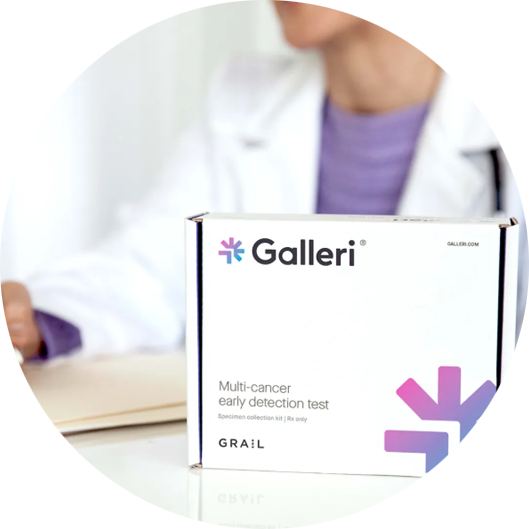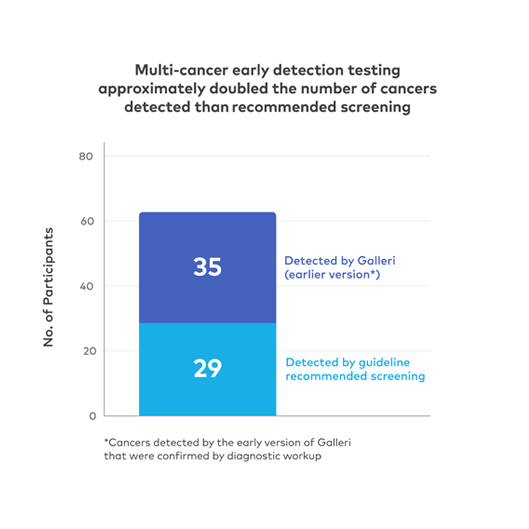
To achieve the benefits of early detection while minimizing harms, multi-cancer early detection requires low false positive rates, highly accurate localization of organ/tissue origin, and high sensitivity of the deadliest cancer types.


Galleri detects a signal shared by more than 50 cancer types1 with a single blood draw, most of which lack routine screening tests. In a clinical study, Galleri approximately doubled the number of cancers detected than recommended screening.2 In the same study, 48% of confirmed cancers that were detected by Galleri were in stages I-II.2 The Galleri goes beyond routine cancer screenings (breast, lung, colon, cervical, and prostate) to screen for many cancers.
Galleri has a specificity of 99.5%, which means that it has a low false positive rate of 0.5%. A low false positive rate helps minimize unnecessary diagnostic procedures.
Specificity = The proportion of people without cancer who received "No Cancer Signal Detected" results.
The Galleri’s positive predictive value (PPV) is 43.1%, meaning that about 4 out of 10 individuals with a Cancer Signal Detected result are expected to have a confirmed cancer diagnosis following diagnostic workup. Galleri’s PPV helps healthcare providers set expectations when discussing appropriate next steps for diagnostic workup.
Positive Predictive Value = The proportion of people with Cancer Signal Detected results diagnosed with cancer
The negative predictive value (NPV) for Galleri is 98.5%, which provides confidence that a No Cancer Signal Detected result is likely a true negative.
Negative Predictive Value = The proportion of people with No Cancer Signal Detected results without cancer.
The Galleri test’s highly accurate Cancer Signal Origin (CSO) prediction is an essential feature of multi-cancer early detection test. It helps clinicians effectively direct a diagnostic evaluation after a Cancer Signal Detection result.
Cancer Signal Origin Accuracy = The proportion of correctly predicted first (or second) CSO prediction(s) among study participants with cancer and "Cancer Signal Detected" results.
| CSO Reported | What Is Included |
|---|---|
| Anus | Anus |
| Bladder, Urothelial Tract | Bladder, Renal Pelvis, Urether, Urethra |
| Bone and Soft Tissue | Skeletal Muscle and other Connective Tissue, Vascular Tissue, Bone and Cartilage |
| Cervix | Cervix |
| Colon, Rectum | Colon, Rectum, Appendix |
| Head and Neck | Oropharynx, Hypopharynx, Nasopharynx, Larynx, Lip and Oral Cavity (including Oral Tongue), Nasal Cavity, Paranasal Sinuses, Major Salivary Glands |
| Hematopoietic and Lymphoid Organs | Bone Marrow, Primary and Secondary Lymphoid Tissue (Lymph Nodes, Extranodal Lymphoid Tissue, Spleen, Thymus) |
| Kidney (excluding renal pelvis) | Kidney |
| Liver, Bile Duct | Liver, Intrahepatic Bile Duct |
| Lung | Lung, Bronchus |
| Melanocyte-containing Tissues/ Skin | Melanocyte-containing Tissues (Skin, Uvea and Muscosal Tissue) |
| Ovary | Ovary, Fallopian Tube, Primary Peritoneum |
| Pancreas, Gallbladder | Pancreas, Extrahepatic Bile Duct, Gallbladder |
| Prostate | Prostate |
| Stomach, Esophagus | Stomach, Esophagus |
| Thyroid | Thyroid |
| Uterus | Uterus |
| Cancer Classes | Sensitivity, proportion of true positives |
|---|---|
| Liver/Bile-duct |
|
| Head and Neck |
|
| Esophagus |
|
| Pancreas |
|
| Ovary |
|
| Colon/Rectum |
|
| Anus |
|
| Cervix |
|
| Urothelial Tract |
|
| Lung |
|
| Plasma Cell Neoplasm |
|
| Gallbladder |
|
| Stomach |
|
| Sarcoma |
|
| Lymphoma |
|
| Other |
|
| Melanoma |
|
| Lymphoid Leukemia |
|
| Bladder |
|
| Breast |
|
| Uterus |
|
| Myeloid Neoplasm |
|
| Kidney |
|
| Prostate |
|
| Thyroid |
|
Galleri has high sensitivity (76.3%) for 12 of the deadliest cancers* that comprise two-thirds of all cancer deaths.1,7 Higher sensitivity for the deadliest cancers helps minimize overdiagnosis and/or overtreatment of indolent cancers.1 More aggressive cancers, such as pancreatic cancer, tend to release more cell-free DNA into the bloodstream at early stages and are more likely to be detected by the Galleri test.1,3 The overall sensitivity for cancer detection is 51.5% for all cancers and across all stages. This provides the opportunity to detect many additional cancers when added to recommended single-cancer screening.
Sensitivity = The proportion of people with cancer who received "Cancer Signal Detected" results.
*Anus, bladder, colon/rectum, esophagus, head and neck, liver/ bile duct, lung, lymphoma, ovary, pancreas, plasma cell neoplasm, and stomach

of test results were Cancer Signal Detected, consistent with clinical studies
of Cancer Signal Detected results had predicted Cancer Signal Origins representing cancers without guideline-recommended screening options
Copyright © 2025 All Right Reserved. A Bio Healthcare Networks Company.